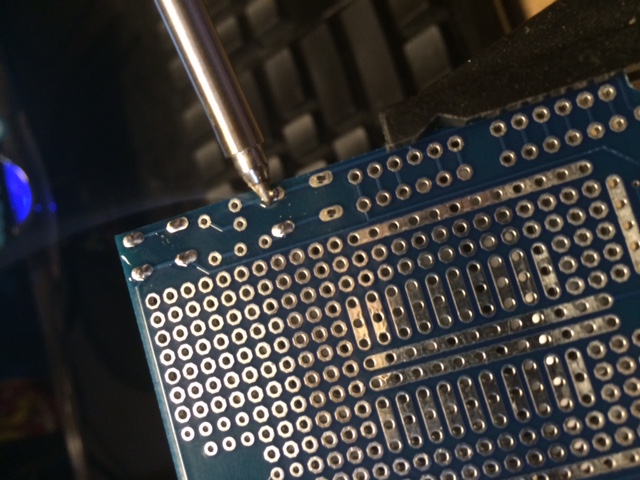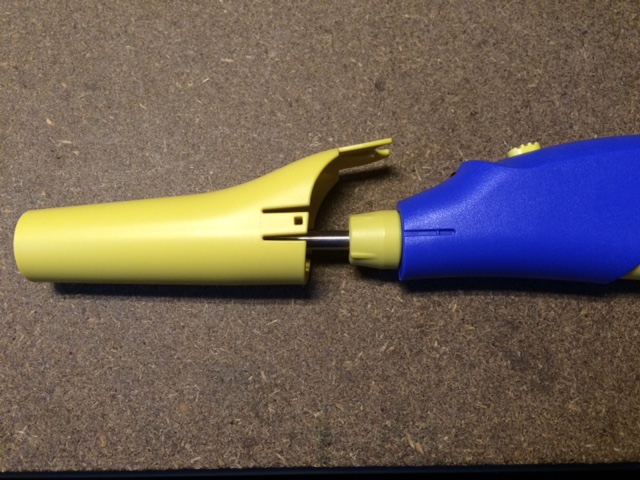I’ve had a few different cordless soldering irons and for the most part they’ve been disappointing. Don’t get me wrong, I don’t expect a portable iron to perform like a nice temperature-regulated bench unit, but most of the ones I’ve tried either don’t work at all or are difficult-to-dangerous to use.
What I need out of a cordless iron is something that I can keep in my toolbox to use in the field for lightweight soldering jobs (circuit boards, small- gauge wire, etc.) for either repairs or prototyping in the field. Something equivalent to a run-of-the-mill 15-30 watt unregulated iron would do the trick. Up until now the best one I’ve had is an old Black & Decker unit that uses butane cartridges (which are possibly no longer made) and has a large tip that makes navigating even large through-hole components a challenge. I’ve tried several times over the last few decades to find a replacement for this iron, but I have yet to find anything better.
So when Sparkfun announced a battery-powered Hakko iron ( https://www.sparkfun.com/products/13151 ) it had my interest. I’ve never owned a Hakko before but I’ve heard from various trusted sources that they are well-made and they make some bench units that look pretty sweet. The price seemed very reasonable, so I thought I should give it a try.
The iron arrived in simple packaging and without a lot of documentation, but the back of the package card covered the essentials. What was surprising to me was that the battery life in terms of run-time was expected to be greater with NiMH cells over alkaline (100min+ vs. 75min).

While alkaline cells produce a higher temp, I was happy to give up a little heat for more run-time and a reusable battery. I picked up 4 2500mah AA NiMH cells for the unit (I bought mine locally but you can order them along with the iron from Sparkfun: https://www.sparkfun.com/products/335 ) and I haven’t used it long enough to exhaust them yet (about 2 hours of on-off so far) so I’ll have to post an update later to attest to the battery life claims.

With batteries charged and in place the unit is well balanced, if a little heavy compared to my butane iron (and of course compared to a mains-powered iron). For the amount of time I used the iron to test it this wasn’t a problem, but I could see how using this device for extended soldering sessions might cause some strain. For me this is unlikely to be an issue since if I were planning to do a lot of soldering I’d do it at the workbench with my regular iron.
The iron heats up surprisingly fast and is ready to solder in 15-20 seconds in the cool winter laboratory. It’s fast enough that turning it off to set it down doesn’t slow you down too much (which is good because it sits a little awkwardly on the bench).

Once up to temp the tip takes solder well and is very efficient at transferring heat to the joint. I was able to rip right along soldering through-hole components about as fast as I can with my bench iron once I got the hang of holding the Hakko. In fact, I got going so fast that I soldered an entire board before realizing that I was soldering the headers in the wrong holes (I guess I’ll test it’s de-soldering capabilities soon).

A nice feature of the kit is that it comes with a cover for the iron that is built in such a way that it doesn’t come in contact with the tip and is ventilated so you can cover the iron while it’s hot and put it away safely (important for something you plan to keep in a toolbox). The cover also interferes with the power switch, forcing it to the “off” position when installed which should prevent it from burning through batteries when you put it away.

Overall I’d say the FX-901 is the iron I’ve been waiting for. It does a fine job for the kind of soldering I need it for, it’s portable, safe®, convenient and inexpensive. It also feels like a quality tool that should hold up to regular use and the ability to use commonly-available alkaline batteries is a nice feature for a field-oriented tool (especially if you don’t remember to charge your tools…). At this point I’d definitely recommend it to anyone doing electronics work, and it may even make a suitable alternative to a mains-powered iron if you don’t do a lot of soldering or don’t have a regular workspace to setup a regulated bench-top unit.
- Jason
